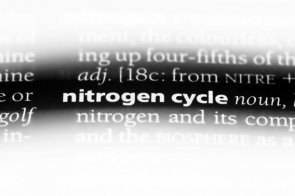
What to Know About the Nitrogen Cycle in Aquaponics
As AquaGrove growers are already well aware, there are various terms to know when it comes to aquaponics. When exploring the learning guide that comes with every Learn and Grow system, it is easy to see how many ways aquaponics can open students, educators and growers of all ages to the possibilities in sustainable gardening and living.
Whether you are new to aquaponics or just curious about the process, there are a few terms that are crucial to understanding the balance and health of your system – one of which is the Nitrogen Cycle.
Let’s first start with the basics of Nitrogen:
Nitrogen is chemical element number 7. It’s a vital element to living organisms and a necessary component in amino acids, the building blocks of proteins. Nitrogen is also a component of nucleic acids in DNA, the blueprint of life – It is the most abundant element in the earth’s atmosphere, with 78 percent of the air around us consisting of nitrogen in the form N2. Other significant forms of nitrogen in ecosystems are ammonia (NH3), nitrite (NO2-), and nitrate (NO3-).
Nitrogen Cycle: Nitrogen from animal waste is excreted in the form of ammonia. Plants intake nitrogen in the form of nitrate. From N2 in the atmosphere to nitrate absorbed as nutrients by plants, nitrogen is converted through different chemical forms by ecological processes and cycled over and over again.
In nitrification, ammonia is converted to nitrates which are usable for plants.
Nitrification includes two steps involving nitrifying bacteria:
Step 1. Ammonia is converted to nitrite (NO2-) by bacteria of the genus Nitrosomonas.
Step 2. Nitrite is converted to nitrate (NO3-) by bacteria of the genus Nitrobacter.
The resulting product, nitrate, is then absorbed as nutrients by plants.
In aquaponic systems, it is very important to understand how the nitrogen cycle works. Since all nutrients are distributed to plants through water, we must be methodical and measured in providing enough useable nitrogen in the water supply.
In aquaponics, the steps of the nitrogen cycle involved are most significantly ammonification, nitrification, and assimilation. Simply put, the fish provide nutrients for the plants, and the plants clean the water for the fish.
Here are the specific steps:
1. Ammonification: Fish excrete waste in the form of ammonia into the water.
2. Nitrification: Nitrosomonas bacteria in the inert medium (eg. coconut coir) of the system convert ammonia to nitrite.
3. Nitrification: Nitrobacter bacteria in the inert medium convert nitrite to nitrate.
4. Assimilation: Plants absorb the nitrate.
The Results:
Nitrogen compounds that are toxic to fish are removed from the water, and plants have the vital nutrients needed for them to thrive and grow.
With continual fish feeding, water replenishment, and plant harvesting, the cycle continues. Keeping the cycle properly maintained and in balance will support a thriving aquaponic garden.
While learning terminology is a good place to start when getting familiar with aquaponics, the terms are only as good as their use. Taking the next steps in starting your own AquaGrove garden is easy and a great way to observe the nitrogen cycle in action. To learn more about starting your own AquaGrove aquaponic garden, contact AquaGrove today!
Sources: Institute for Systems Biology (ISB) Project Feed 1010
